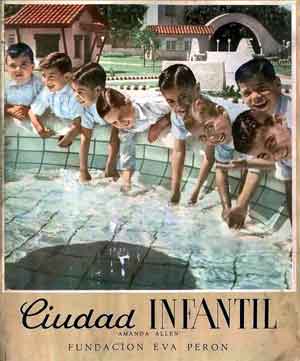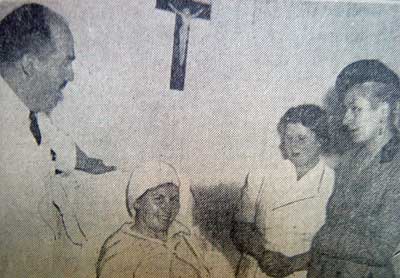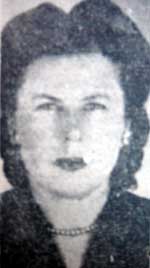|

Cover of a 1950 publication
about
"Amanda Allen's Children City" orphanage
(Biblioteca Reservada del
Congreso, Buenos Aires) |
Eventually, the Foundation went beyond the geographical
boundaries and extended its medical and social relief plans to
other Latin American countries sending ambulances, nurses,
clothing, food and medicines. After the earthquake of August
1949 in
Ecuador, the Foundation sent six FAMA [16]
planes carrying food, clothing, medicines, instruments,
physicians and nurses. Amanda Allen was a member of the aid team
travelling in one of the Foundation buses when it fell on a
cliff with a result of several wounded. Moreover, on the flight
back to Buenos Aires, the plane set fire in Castilla and
four crew members died. Amanda Allen escaped but was seriously
wounded. Other staff member, the officer Guillermo MacLoughlin
was also wounded. Both were awarded by Perón and Evita in a
public homage at Colón theatre of Buenos Aires. One of the most
important works of the Foundation, "Ciudad Infantil",
[17]
was named after Amanda Allen in spite of the toponymic fashion
taking place during this period, by which the majority of public
institutions, cities and even provinces were renamed before the
president and the first lady.
[18]
Other Irish Argentine women had different roles in the
political activity of this period, including Catalina Allen,
Norma Egan, Nila Lloyd, and Margarita Wellington O'Berty. They
were members of the first significant women's mobilisation in
Argentina. In 1945 Bulina G. O'Neill was a member of the Women's
Organisation Unit in the Labour Party. In July 1949 Eva Perón created the Women's Peronist
Party to channel out the political movement of women after the
proclamation of the suffrage act of 1947. The party was chaired
by Evita and was fundamental to Juan D. Perón's electoral victory in
1951.
The Peronist Women's Party was established on 26 July 1949 with a basis
of twenty-three delegate census takers – one from every province
or national territory – who were appointed directly by the
party's president. One of these delegates was Catalina Allen.
Their first assignment was to take the census of Peronist women
in the country. The delegates represented Eva Perón and followed
her in the organisation's hierarchy. Evita portrayed this group
of "very young women ... My assistants were tireless social
workers, fervent Peronists with no time to themselves, and
fanatic supporters of Perón's cause. I required from them great
sacrifices, like leaving their homes and jobs. Virtually, they
left their lives to start with a new, different, intense and
difficult one. Those were the women I needed, untiring,
fervent, fanatic... Our venture required brave women, willing to
work day and night” (Perón 1951: 291).
|

Eva Perón calls on Rivadavia Hospital to
visit Amanda Allen
(Democracia, 2 October 1949) |
Catalina Allen was assigned to Buenos Aires, the
most populated and important province for the elections, which
at that time has a potential size of 1.2 million women voters.
In a time when it was unusual for women to give public speeches,
Catalina Allen was an earnest speaker. When she took charge of
her new responsibilities, using elements of the religious
discourse, Allen noted that "the only thing we wish and aspire
to is to become authentic, loyal and disinterested missionaries
of Perón's Justicialist teaching, and to be followers of our
distinguished leader Evita, who personifies the essence and
identity of the Peronist women's movement" (El Laborista,
6 November 1949). Allen was responsible for the organisation of
the new party in the Buenos Aires province, a task involving the
promotion of new memberships and the opening of "basic units"
(regional working groups) composed exclusively of women.
Additionally, she appointed sub-delegates who, in their turn,
would lead individual women basic units. There were at least two
basic units in every district, therefore Catalina's work must
have been extremely burdensome. Everyday work included taking
census of the district, promoting memberships, preaching the Peronist doctrine, giving talks and organising meetings.
Furthermore, Catalina Allen would implement special courses for
women as well as research the social needs in the province, so that the
party would network with Eva Perón Foundation. Thanks to the
toilsome efforts of Catalina Allen and her colleagues,
sixty-three per cent of the women constituency in Buenos Aires
voted for Peronist candidates. For unknown reasons Allen was not
appointed MP candidate, and after the elections she cut herself
off politics for ever.
|

Catalina Allen, delegate of the Women Peronist Party in
Buenos Aires province
(Democracia, 30 October
1949) |
Sub-delegates worked in the neighbourhood trying to
attract new members to the party. There were over 3,600
sub-delegates throughout the country, some of them with Irish
roots. Nila Lloyd (b. 1922), a social worker and nurse graduated
from the Red Cross, chaired up to 1955 a basic unit in the
significant constituency of Belgrano (1940 Chenault street). In
1949 Margarita Wellington de O'Berty was appointed sub-delegate
in San Antonio de Areco. However, she did not succeed on meeting
the high expectations of skills and efforts and therefore she was
considered redundant. O'Berty was replaced by Norma Egan, who
was directly appointed by Eva Perón. [19]
Egan went to visit the Foundation headquarters in search of a
job, and in an audience with Evita "the Señora asked me
many things and told me that she needed my services to support
the political
activity" (author's interview with Mrs. Egan). In the region of
San Antonio de Areco, with an overwhelming rural population,
Egan travelled through the camps driving a Land Rover
jeep. Landowners and estancieros "knew me well, since my
father owned a herd of horses and my aunts were the local
teachers. One of them was the schoolmistress and they helped me
with my job." Norma asked for authorisations from the
estancieros and then addressed the wives of cattle hands and
labourers. "I used to tell them how pretty she [Evita] was, and that
people usually left [the Foundation offices] with gifts and
machines ... and they were delighted ... I explained that they
would live better and asked them to help us with their votes."
In order to get new memberships Norma Egan "went to the public
houses and ate salami with a glass of wine, or sipped maté
when visiting the families." After seven months of intense and
successful work in San Antonio de Areco, Evita appointed Norma
Egan as MP candidate to the provincial parliament of Buenos
Aires. Influenced by their gender-biased view of political
activities, when they learnt the news the men of Areco "got mad
at me and wanted to kill me ... But I replied that that was
granted by Eva Perón." On 11 November 1951 Norma Egan was sworn
MP with the first group of elected women in the province.
This brief account of Irish-Argentine men and women who
played significant political roles in the early Peronism is a
short illustration of their involvement in politics.
Understanding their interaction with the larger context of the
country's history may help to establish an adequate background
to the later participation of thousands of Irish and other
immigrant families in the last Peronist period (1973-1976) and
the subsequent Dirty War derived of the conflict between the
military forces and diverse guerrilla groups. Due to feuds and
rancours that are frequently prevalent among Argentines even in
present times, there is a particular scarcity of primary sources
in many periods of the country's history. Hence, it is our duty
to reassemble the pieces, and I hope that family or personal
acquaintance with those who had other political roles will help
to complete these neglected stories.
1 -
2 - 3
References and Newspapers
- Perón,
Eva, La razón de mi vida (Buenos Aires: Peuser, 1951).
The Southern Cross
(Buenos Aires).
|




